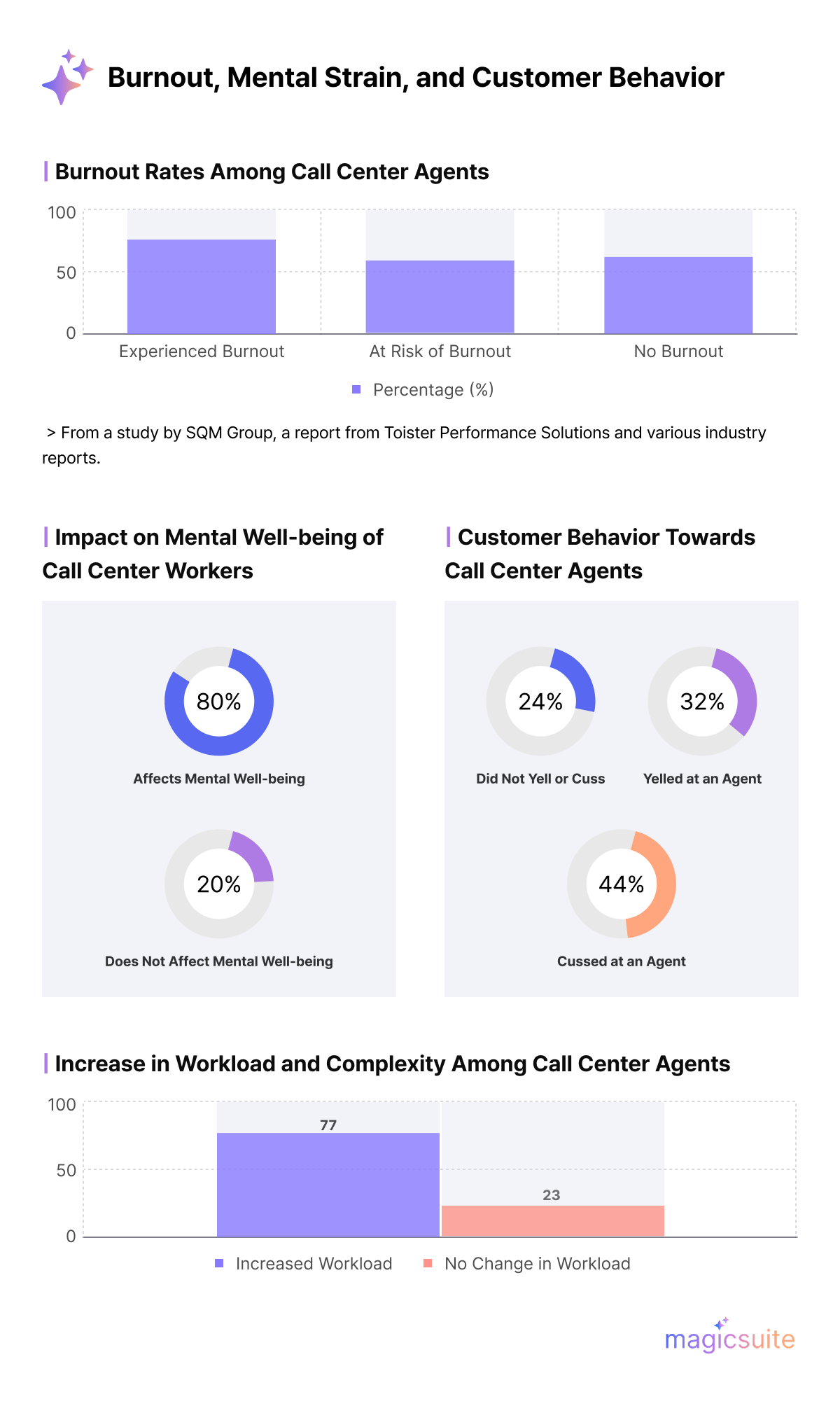Discover how to reduce Agent Burnout using automation and AI chatbots to empower support teams, boost morale, and improve customer experience.

Imagine being in a pressure cooker. That’s what many customer service agents feel every single day – juggling dozens of inquiries, managing emotional calls, and racing against KPIs. This leads to a common but costly problem: Agent Burnout.
Fortunately, there's a light at the end of the tunnel, and it comes in the form of smart automation and AI. This article examines how to strategically reduce agent burnout through automation.
Agent Burnout is more than just feeling tired. It's a state of emotional, physical, and mental exhaustion caused by prolonged stress and job-related pressures. It leads to disengagement, lack of motivation, and ultimately, poor performance. Statistics paint a clear picture of the severity of this problem, highlighting the urgent need to reduce agent burnout:

Spotting burnout early can prevent long-term damage. Warning signs include:
Recognizing these symptoms early allows for timely intervention, whether through process changes or support.
Three words: volume, complexity, and pressure. Modern customers expect instant, personalized responses. This puts agents in a tight spot, often juggling multiple channels, repetitive inquiries, and complex queries simultaneously.
When burnout creeps in, it shows. Customer satisfaction drops, error rates rise, and your top agents begin to leave. High turnover is expensive, and the cost of training new agents adds up fast. Here are some of the top causes of agent burnout in the customer service industry.
Customer service agents often face continuous handling of customer complaints, high call volumes, and tight performance metrics. This constant pressure can lead to emotional and mental fatigue, contributing significantly to agent burnout.
A significant portion of a customer service agent's day can be consumed by repetitive, low-value tasks, such as answering frequently asked questions (FAQs) or updating basic customer information. This monotony can lead to boredom and a sense of underutilization, fueling agent burnout.
Customer service roles require significant emotional labor, where agents must manage their own emotions while responding to customers, often dealing with individuals who are frustrated or angry.
Inadequate training can leave customer service agents feeling unprepared to handle complex issues, leading to increased stress and frustration. A lack of support from management can also contribute to agent burnout.
Jeff Toister of Toister Solutions highlights that a significant risk of burnout for customer service workers is directed attention fatigue, a form of mental fatigue caused by trying to focus intently for extended periods.
Automation is not about replacing human customer service agents; it is about empowering them by offloading mundane and repetitive tasks. Through marketing automation, businesses can significantly reduce agent burnout and create a more fulfilling work environment for their customer service teams.
Automation takes over routine inquiries and repetitive tasks. This includes answering frequently asked questions (FAQs), providing order status updates, handling basic account inquiries, and guiding customers through basic processes. Automating these low-value interactions allows customer service agents to be freed from the monotony that often leads to boredom and mental fatigue.
2. Providing Real-time Agent Support
AI-powered tools can provide real-time information, suggest responses, and even pull up relevant customer history during interactions. This reduces the cognitive load on agents, enabling them to resolve issues more quickly and accurately.
For instance, knowledge management systems integrated with AI can instantly retrieve answers to complex questions, preventing agents from having to search through vast databases, thereby reducing stress, improving efficiency, and helping to reduce agent burnout.
3. Optimizing Workload and Distribution
Automation helps direct customer questions to the right human agent, especially for complicated issues. This stops agents from getting overwhelmed with too many tough cases. Automation also helps during busy times by handling many inquiries first, reducing the load on agents.
4. Reducing "Swivel Chair" Tasks
Many customer service roles involve agents switching between multiple systems and applications to gather information or complete tasks, often referred to as "swivel chair" tasks.
Automation can integrate these disparate systems, streamlining workflows and reducing the need for manual data entry or information retrieval across different platforms.
5. Improving Agent Satisfaction and Reducing Turnover
When customer service agents have fewer repetitive tasks and better tools, they feel happier at work. This happiness leads to lower turnover rates, which are usually very high in call centers (30-50% each year).
Having fewer people leave means there are more experienced agents, better service for customers, and big cost savings for businesses. It also helps prevent agent burnout.
Checkout: 7 Best Marketing Automation Tools for Startups
AI chatbots like Magictalk are a prime example of automation in action within customer service. These intelligent conversational agents leverage artificial intelligence, machine learning, and natural language understanding (NLU) to simulate human-like conversations. Here’s how AI Chatbots contribute to reducing agent burnout:
AI chatbots for Ecommerce never sleep. They can provide global, 24/7 support, so customers receive immediate assistance at any time, even when human customer service agents are offline. When customers receive prompt answers to their straightforward questions, they are less likely to be frustrated when they eventually connect with a live agent.
Many customer service interactions are about frequently asked questions and routine requests. AI chatbots are great at answering these common queries, like checking order status, account questions, product details, and basic troubleshooting. This allows agents to focus on more interesting tasks, which helps prevent burnout.
AI chatbots can be programmed with extensive knowledge bases, allowing them to provide accurate and consistent information. This often leads to higher rates of first-contact resolution for simple issues without needing to be transferred or wait for a human customer service agent. This efficiency reduces the overall ticket volume that reaches human agent, easing their workload.
While AI chatbots are good at handling routine tasks, they know when to pass a complicated or sensitive issue to a human agent. They can share all the previous conversation details, so the human agent doesn’t have to start over, saving time and reducing customer frustration.
AI chatbots collect valuable data on customer interactions, common queries, and areas of pain. This data can be analyzed to identify trends, improve self-service options, and even inform product or service improvements. With MagicTalk, teams experience both qualitative and quantitative improvements.
Curious? Also read: What Happens in an AI Chatbot Conversation?
Here’s a word of caution though, avoid too much automation or it can backfire. If customers feel like they’re talking to a wall, they’ll leave frustrated. Make sure the AI chatbot offers the option to connect with a live agent at any time, like MagicTalk. Avoid using AI for emotionally sensitive or high-stakes situations—humans still do empathy best. Balance efficiency with empathy.
Agent Burnout can quietly erode your support team from the inside out. But with the strategic use of automation, it doesn’t have to. Let's stop the idea that automation replaces humans.
AI automation is about letting them be more human. Satisfied agents serve customers more effectively, resulting in higher loyalty and lifetime value. Give your agents the space and support to do their best work, and they’ll reward you with dedication, creativity, and world-class service.

Hanna is an industry trend analyst dedicated to tracking the latest advancements and shifts in the market. With a strong background in research and forecasting, she identifies key patterns and emerging opportunities that drive business growth. Hanna’s work helps organizations stay ahead of the curve by providing data-driven insights into evolving industry landscapes.